
- •Preface
- •About This Book
- •Acknowledgments
- •Contents at a Glance
- •Contents
- •Relaxing at the Beach
- •Dressing the Scene
- •Animating Motion
- •Rendering the Final Animation
- •Summary
- •The Interface Elements
- •Using the Menus
- •Using the Toolbars
- •Using the Viewports
- •Using the Command Panel
- •Using the Lower Interface Bar Controls
- •Interacting with the Interface
- •Getting Help
- •Summary
- •Understanding 3D Space
- •Using the Viewport Navigation Controls
- •Configuring the Viewports
- •Working with Viewport Backgrounds
- •Summary
- •Working with Max Scene Files
- •Setting File Preferences
- •Importing and Exporting
- •Referencing External Objects
- •Using the File Utilities
- •Accessing File Information
- •Summary
- •Customizing Modify and Utility Panel Buttons
- •Working with Custom Interfaces
- •Configuring Paths
- •Selecting System Units
- •Setting Preferences
- •Summary
- •Creating Primitive Objects
- •Exploring the Primitive Object Types
- •Summary
- •Selecting Objects
- •Setting Object Properties
- •Hiding and Freezing Objects
- •Using Layers
- •Summary
- •Cloning Objects
- •Understanding Cloning Options
- •Mirroring Objects
- •Cloning over Time
- •Spacing Cloned Objects
- •Creating Arrays of Objects
- •Summary
- •Working with Groups
- •Building Assemblies
- •Building Links between Objects
- •Displaying Links and Hierarchies
- •Working with Linked Objects
- •Summary
- •Using the Schematic View Window
- •Working with Hierarchies
- •Setting Schematic View Preferences
- •Using List Views
- •Summary
- •Working with the Transformation Tools
- •Using Pivot Points
- •Using the Align Commands
- •Using Grids
- •Using Snap Options
- •Summary
- •Exploring the Modifier Stack
- •Exploring Modifier Types
- •Summary
- •Exploring the Modeling Types
- •Working with Subobjects
- •Modeling Helpers
- •Summary
- •Drawing in 2D
- •Editing Splines
- •Using Spline Modifiers
- •Summary
- •Creating Editable Mesh and Poly Objects
- •Editing Mesh Objects
- •Editing Poly Objects
- •Using Mesh Editing Modifiers
- •Summary
- •Introducing Patch Grids
- •Editing Patches
- •Using Modifiers on Patch Objects
- •Summary
- •Creating NURBS Curves and Surfaces
- •Editing NURBS
- •Working with NURBS
- •Summary
- •Morphing Objects
- •Creating Conform Objects
- •Creating a ShapeMerge Object
- •Creating a Terrain Object
- •Using the Mesher Object
- •Working with BlobMesh Objects
- •Creating a Scatter Object
- •Creating Connect Objects
- •Modeling with Boolean Objects
- •Creating a Loft Object
- •Summary
- •Understanding the Various Particle Systems
- •Creating a Particle System
- •Using the Spray and Snow Particle Systems
- •Using the Super Spray Particle System
- •Using the Blizzard Particle System
- •Using the PArray Particle System
- •Using the PCloud Particle System
- •Using Particle System Maps
- •Controlling Particles with Particle Flow
- •Summary
- •Understanding Material Properties
- •Working with the Material Editor
- •Using the Material/Map Browser
- •Using the Material/Map Navigator
- •Summary
- •Using the Standard Material
- •Using Shading Types
- •Accessing Other Parameters
- •Using External Tools
- •Summary
- •Using Compound Materials
- •Using Raytrace Materials
- •Using the Matte/Shadow Material
- •Using the DirectX 9 Shader
- •Applying Multiple Materials
- •Material Modifiers
- •Summary
- •Understanding Maps
- •Understanding Material Map Types
- •Using the Maps Rollout
- •Using the Map Path Utility
- •Using Map Instances
- •Summary
- •Mapping Modifiers
- •Using the Unwrap UVW modifier
- •Summary
- •Working with Cameras
- •Setting Camera Parameters
- •Summary
- •Using the Camera Tracker Utility
- •Summary
- •Using Multi-Pass Cameras
- •Creating Multi-Pass Camera Effects
- •Summary
- •Understanding the Basics of Lighting
- •Getting to Know the Light Types
- •Creating and Positioning Light Objects
- •Viewing a Scene from a Light
- •Altering Light Parameters
- •Working with Photometric Lights
- •Using the Sunlight and Daylight Systems
- •Using Volume Lights
- •Summary
- •Selecting Advanced Lighting
- •Using Local Advanced Lighting Settings
- •Tutorial: Excluding objects from light tracing
- •Summary
- •Understanding Radiosity
- •Using Local and Global Advanced Lighting Settings
- •Working with Advanced Lighting Materials
- •Using Lighting Analysis
- •Summary
- •Using the Time Controls
- •Working with Keys
- •Using the Track Bar
- •Viewing and Editing Key Values
- •Using the Motion Panel
- •Using Ghosting
- •Animating Objects
- •Working with Previews
- •Wiring Parameters
- •Animation Modifiers
- •Summary
- •Understanding Controller Types
- •Assigning Controllers
- •Setting Default Controllers
- •Examining the Various Controllers
- •Summary
- •Working with Expressions in Spinners
- •Understanding the Expression Controller Interface
- •Understanding Expression Elements
- •Using Expression Controllers
- •Summary
- •Learning the Track View Interface
- •Working with Keys
- •Editing Time
- •Editing Curves
- •Filtering Tracks
- •Working with Controllers
- •Synchronizing to a Sound Track
- •Summary
- •Understanding Your Character
- •Building Bodies
- •Summary
- •Building a Bones System
- •Using the Bone Tools
- •Using the Skin Modifier
- •Summary
- •Creating Characters
- •Working with Characters
- •Using Character Animation Techniques
- •Summary
- •Forward versus Inverse Kinematics
- •Creating an Inverse Kinematics System
- •Using the Various Inverse Kinematics Methods
- •Summary
- •Creating and Binding Space Warps
- •Understanding Space Warp Types
- •Combining Particle Systems with Space Warps
- •Summary
- •Understanding Dynamics
- •Using Dynamic Objects
- •Defining Dynamic Material Properties
- •Using Dynamic Space Warps
- •Using the Dynamics Utility
- •Using the Flex Modifier
- •Summary
- •Using reactor
- •Using reactor Collections
- •Creating reactor Objects
- •Calculating and Previewing a Simulation
- •Constraining Objects
- •reactor Troubleshooting
- •Summary
- •Understanding the Max Renderers
- •Previewing with ActiveShade
- •Render Parameters
- •Rendering Preferences
- •Creating VUE Files
- •Using the Rendered Frame Window
- •Using the RAM Player
- •Reviewing the Render Types
- •Using Command-Line Rendering
- •Creating Panoramic Images
- •Getting Printer Help
- •Creating an Environment
- •Summary
- •Creating Atmospheric Effects
- •Using the Fire Effect
- •Using the Fog Effect
- •Summary
- •Using Render Elements
- •Adding Render Effects
- •Creating Lens Effects
- •Using Other Render Effects
- •Summary
- •Using Raytrace Materials
- •Using a Raytrace Map
- •Enabling mental ray
- •Summary
- •Understanding Network Rendering
- •Network Requirements
- •Setting up a Network Rendering System
- •Starting the Network Rendering System
- •Configuring the Network Manager and Servers
- •Logging Errors
- •Using the Monitor
- •Setting up Batch Rendering
- •Summary
- •Compositing with Photoshop
- •Video Editing with Premiere
- •Video Compositing with After Effects
- •Introducing Combustion
- •Using Other Compositing Solutions
- •Summary
- •Completing Post-Production with the Video Post Interface
- •Working with Sequences
- •Adding and Editing Events
- •Working with Ranges
- •Working with Lens Effects Filters
- •Summary
- •What Is MAXScript?
- •MAXScript Tools
- •Setting MAXScript Preferences
- •Types of Scripts
- •Writing Your Own MAXScripts
- •Learning the Visual MAXScript Editor Interface
- •Laying Out a Rollout
- •Summary
- •Working with Plug-Ins
- •Locating Plug-Ins
- •Summary
- •Low-Res Modeling
- •Using Channels
- •Using Vertex Colors
- •Rendering to a Texture
- •Summary
- •Max and Architecture
- •Using AEC Objects
- •Using Architectural materials
- •Summary
- •Tutorial: Creating Icy Geometry with BlobMesh
- •Tutorial: Using Caustic Photons to Create a Disco Ball
- •Summary
- •mental ray Rendering System
- •Particle Flow
- •reactor 2.0
- •Schematic View
- •BlobMesh
- •Spline and Patch Features
- •Import and Export
- •Shell Modifier
- •Vertex Paint and Channel Info
- •Architectural Primitives and Materials
- •Minor Improvements
- •Choosing an Operating System
- •Hardware Requirements
- •Installing 3ds max 6
- •Authorizing the Software
- •Setting the Display Driver
- •Updating Max
- •Moving Max to Another Computer
- •Using Keyboard Shortcuts
- •Using the Hotkey Map
- •Main Interface Shortcuts
- •Dialog Box Shortcuts
- •Miscellaneous Shortcuts
- •System Requirements
- •Using the CDs with Windows
- •What’s on the CDs
- •Troubleshooting
- •Index
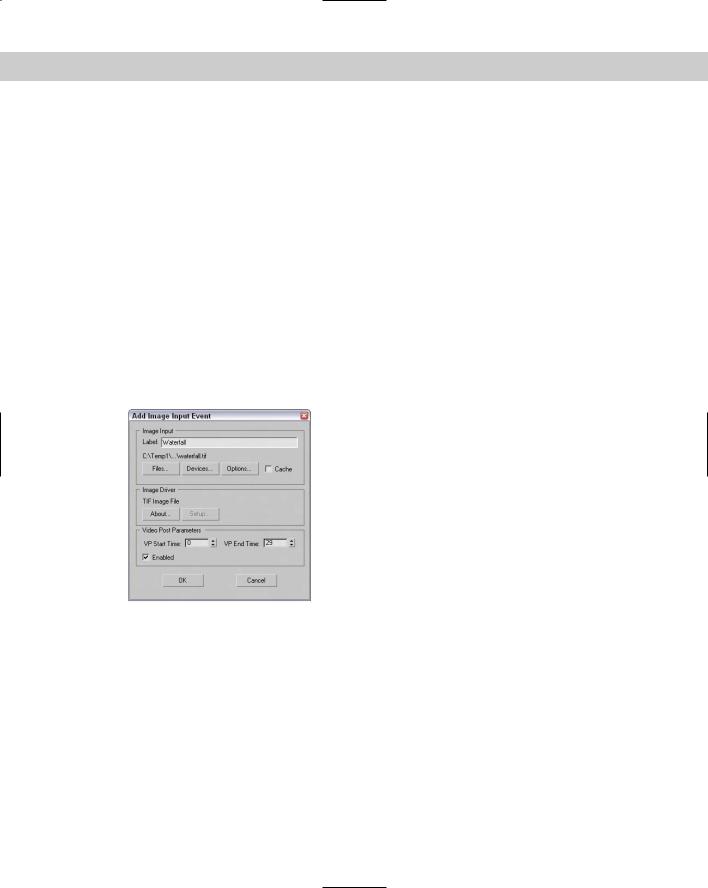
Chapter 47 Using the Video Post Interface 1097
The Time Output section enables you to specify which frames to render, and the Output Size section lets you specify the size of the output. The Custom selection lets you enter Width and Height values, or you can use one of the presets in the drop-down list or one of the preset resolution buttons. This dialog box also includes controls for entering the Image Aspect and Pixel Aspect ratios.
The Output options let you select to keep the Progress dialog box open, to render to the Rendered Frame Window, and/or to use network rendering. When you’re ready to render the queue, click the Render button.
Adding and Editing Events
The seven event types that you can add to the queue are Image Input, Scene, Image Filter, Image Layer, Loop, External, and Image Output. If no events are selected, then adding an event positions the event at the bottom of the list. If an event is selected, the added event becomes a sub-event under the selected event.
Every event dialog box, such as the Add Input Image Event dialog box shown in Figure 47-3, includes a Label field where you can name the event. This name shows up in the queue window and is used to identify the event.
Figure 47-3: The Add Image Input Event dialog box lets you load an image to add to the queue.
Each event dialog box includes a Video Post Parameters section. This section contains VP Start Time and VP End Time values for defining precisely the length of the Video Post range. It also includes an Enabled option for enabling or disabling an event. Disabled events are grayed out in the queue.
To edit an event, you simply need to double-click its name in the Queue pane to open an Edit Event dialog box.
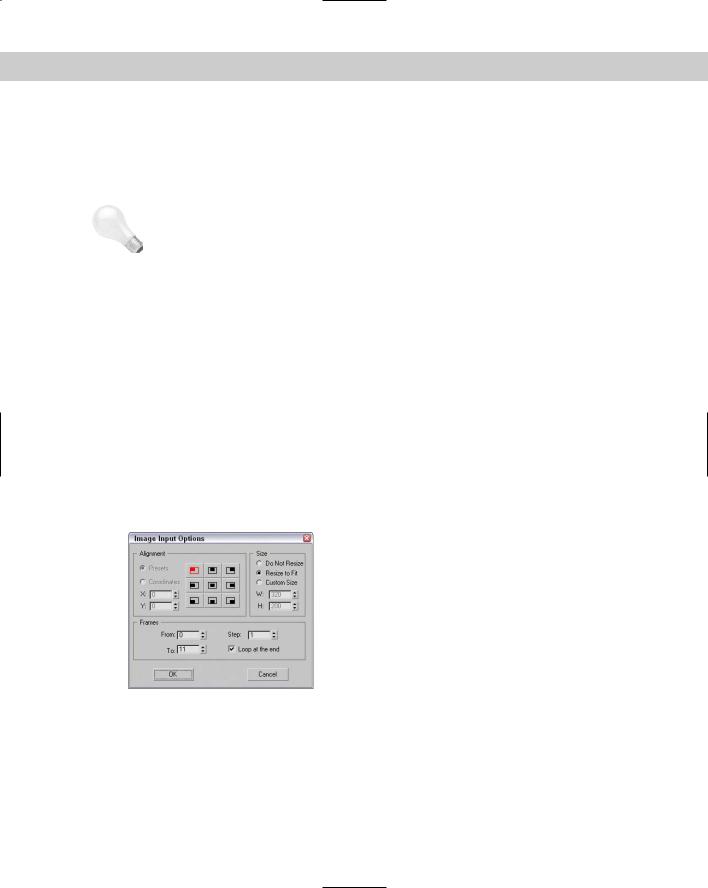
1098 Part XI Compositing and Post-Production
|
Adding an image input event |
|
The Add Image Input Event dialog box lets you add a simple image to the queue. For example, |
|
you can add a background image using this dialog box rather than the Environment dialog |
|
box. To open the Add Image Input Event dialog box, click the Add Image Input Event button |
|
on the toolbar. |
Tip |
If you don’t name the image event, then the filename appears in the Queue pane as the |
|
name for the event. |
|
The Files button in this dialog box opens the Select Image File for Video Post Input dialog box |
|
where you can locate an image file to load from the hard disk or network. Supported image |
|
types include .AVI, .BMP, Kodak Cineon, Combustion, .FLC, .GIF, .IFL, .JPEG, .PIC, .PNG, .PSD, |
|
.MOV, .SGI Image, .RLA, .RPF, .TGA, .TIF, and .YUV. The Devices button lets you access an |
|
external device such as a video recorder. The Options button becomes enabled when you |
|
load an image. It opens the Image Input Options dialog box, shown in Figure 47-4. The Cache |
|
option causes the image to be loaded into memory, which can speed up the Video Post pro- |
|
cess by not requiring the image to be loaded for every frame. |
|
The Image Driver section of the Add Image Input Event dialog box lets you specify the settings |
|
for the image driver, such as the compression settings for an .AVI file. Clicking the Setup button |
|
opens a dialog box of options available for the selected format. |
|
The Image Input Options dialog box, shown in Figure 47-4, lets you set the alignment, size, |
|
and frames where the image appears. The Alignment section of the Image Input Options dia- |
|
log box includes nine different presets for aligning the image. Preset options include top-left |
|
corner, top centered, top-right corner, left centered, centered, right centered, bottom-left cor- |
|
ner, bottom centered, and bottom-right corner. You can also use the Coordinates option to |
|
specify in pixels the image’s upper-left corner. |
Figure 47-4: The Image Input Options dialog box lets you align and set the size of the image.
In the Size section of this dialog box, you can control the size of the image, using the Do Not Resize, Resize to Fit, or Custom Size options. The Custom Size option lets you enter Width and Height values.

Chapter 47 Using the Video Post Interface 1099
The Frames section applies only to animation files. The From and To values define which frames of the animation to play. The Step value lets you play every nth frame as specified. The Loop at the End value causes the animation to loop back to the beginning when finished.
Adding scene events
A scene event is the rendered scene that you’ve built in Max. When you click the Add Scene Event button on the toolbar, the Add Scene Event dialog box shown in Figure 47-5 opens. This dialog box lets you specify the scene ranges and define the render options.
Figure 47-5: The Add Scene Event dialog box lets you specify which viewport to use to render your scene.
Below the Label field where you can name the event is a drop-down list that lets you select which viewport to use to render your scene. The active viewport is selected by default. The Render Options button opens the Render Scene panel, except the Render button has been replaced with OK and Cancel buttons because the rendering is initiated with the Execute Sequence button.
Cross- |
For more information about the Render Scene panel, see Chapter 41, “Rendering Basics.” |
Reference |
|
The Scene Options section of the Add Scene Event dialog box also includes an option for enabling Scene Motion Blur. This motion blur type is different from the object motion blur that is set in the Object Properties dialog box. Scene motion blur is applied to the entire image and is useful for blurring objects that are moving fast. The Duration (frames) value sets how long the blur effect is computed per frame. The Duration Subdivisions value is how many computations are done for each duration. The Dither % value sets the amount of dithering to use for blurred sections.
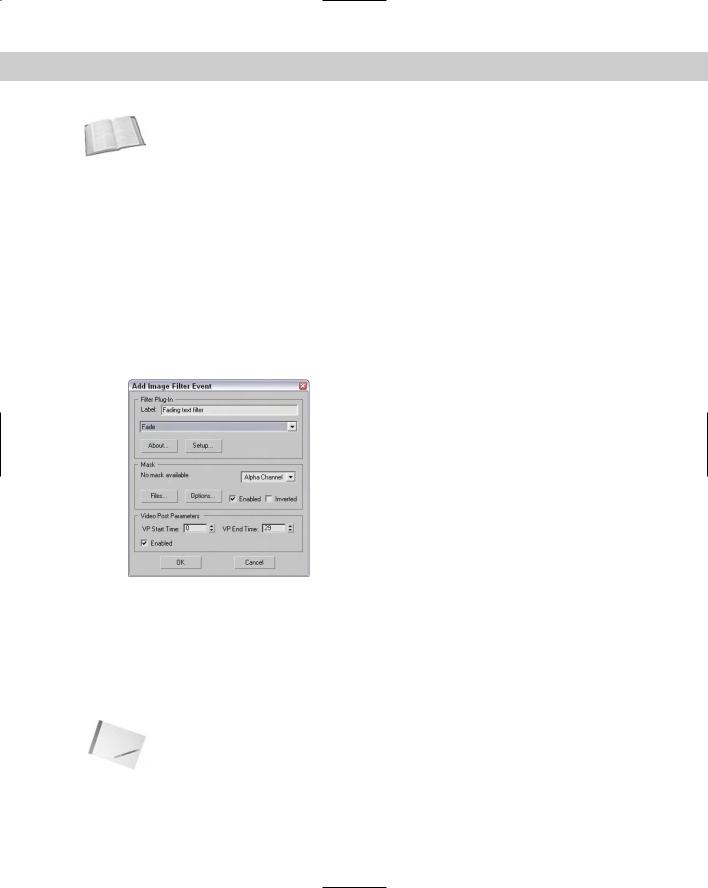
1100 Part XI Compositing and Post-Production
Cross- |
You can find more information on object motion blur in Chapter 6, “Selecting Objects and |
Reference |
Setting Object Properties.” |
|
In the Scene Range section, the Scene Start and Scene End values let you define the range for the rendered scene. The Lock Range Bar to Scene Range option maintains the range length as defined in the Time Slider, though you can still reposition the start of the rendered scene. The Lock to Video Post Range option sets the range equal to the Video Post range.
Adding image filter events
The Add Image Filter Event button on the toolbar opens the Add Image Filter Event dialog box, shown in Figure 47-6, where you can select from many filter types. The available filters are included in a drop-down list under the Label field.
Below the filter drop-down list are two buttons: About and Setup. The About button gives some details about the creator of the filter. The Setup button opens a separate dialog box that controls the filter. The dialog box that appears depends on the type of filter that you selected in the drop-down list.
Figure 47-6: The Add Image Filter Event dialog box lets you select from many filter types.
Several filters require a mask such as the Image Alpha filter. To open a bitmap image to use as the mask, click the Files button in the Mask section and select the file in the Select Mask Image dialog box that opens. The Options button opens the Image Input Options dialog box for aligning and sizing the mask. A drop-down list lets you select the channel to use. Possible channels include Red, Green, Blue, Alpha, Luminance, Z Buffer, Material Effects, and Object. The mask can be Enabled or Inverted.
Note Several Lens Effects filters are also included in the drop-down list. These filters use an advanced dialog box with many options, which is covered in the “Working with Lens Effect Filters” section later in the chapter.
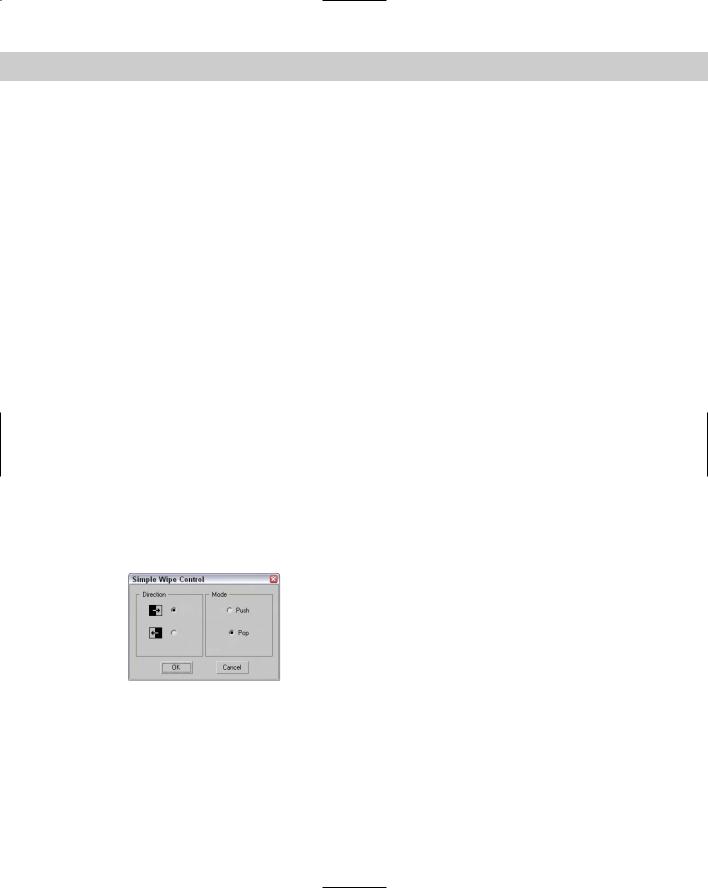
Chapter 47 Using the Video Post Interface 1101
Contrast filter
You use the Contrast filter to adjust the brightness and contrast. Selecting this filter and clicking the Setup button opens the Image Contrast Control dialog box. This simple dialog box includes values for Contrast and Brightness. Both values can be set from 0 to 1. The Absolute option computes the center gray value based on the highest color value. The Derived option uses an average value of the components of all three colors (red, green, and blue).
Fade filter
You can use the Fade filter to fade out the image over time. You can select it from the dropdown list. The Fade Image Control dialog box lets you select to fade either In or Out. The fade takes place over the length of the range set in the Range pane.
Image Alpha filter
The Image Alpha filter sets the alpha channel as specified by the mask. This filter doesn’t have a setup dialog box.
Negative filter
The Negative filter inverts all the colors, as in the negative of a photograph. The Negative Filter dialog box includes a simple Blend value.
Pseudo Alpha filter
The Pseudo Alpha filter sets the alpha channel based on the pixel located in the upper-left corner of the image. This filter can make an unrendered background transparent. When this filter is selected, the Setup button is disabled, because it doesn’t have a setup dialog box.
Simple Wipe filter
The Simple Wipe filter removes the image by replacing it with a black background. The length of the wipe is determined by the event’s time range. The Simple Wipe Control dialog box, shown in Figure 47-7, lets you wipe from the left to the right or from the right to the left. You can also set the mode to Push, which displays the image, or to Pop, which erases it.
Figure 47-7: The Simple Wipe Control dialog box lets you select which direction to wipe the image.
Starfield filters
The Starfield filter creates a starfield image. By using a camera, you can motion blur the stars. The Stars Control dialog box, shown in Figure 47-8, includes a Source Camera drop-down list that you can use to select a camera.
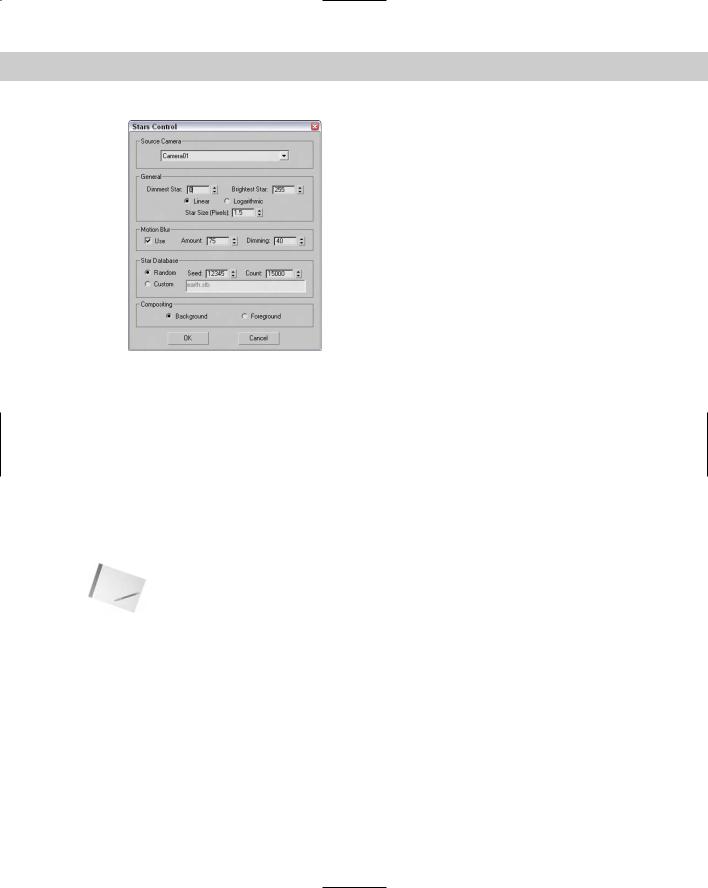
1102 Part XI Compositing and Post-Production
Figure 47-8: The Stars Control dialog box lets you load a custom database of stars.
The General section sets the brightness and size of the stars. You can specify brightness values for the Dimmest Star and the Brightest Star. The Linear and Logarithmic options use two different algorithms to compute the brightness values of the stars as a function of distance.
The Star Size value sets the size of the stars in pixels. Size values can range from 0.001 to 100.
The Motion Blur settings let you enable motion blurring, set the blur Amount, and specify a Dimming value.
The Star Database section includes settings for defining how the stars are to appear. The Random option displays stars based on the Count value, and the random Seed determines the randomness of the star’s positions. The Custom option reads a star database specified in the Database field.
Note |
Max includes a starfield database named earth.stb that includes the stars as seen from Earth. |
You can also specify whether the stars are composited in the background or foreground.
Tutorial: Creating space backdrops
Space backgrounds are popular backdrops, and Max includes a special Video Post filter for creating starfield backgrounds. You would typically want to use the Video Post interface to render the starfield along with any animation that you’ve created, but in this tutorial, we just render a starfield for a single planet that we’ve created and outfitted with a planet material.
To create a starfield background, follow these steps:
1.Open the Planet with starfield background.max file from the Chap 47 directory on the CD-ROM.
This file includes a simple space scene with a camera because the Starfield filter requires a camera.
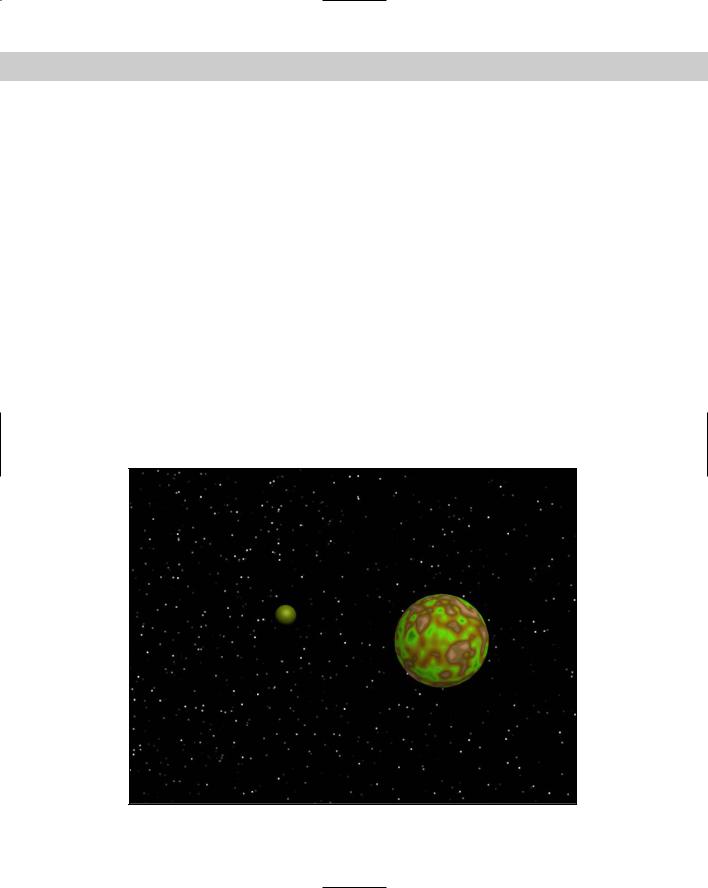
Chapter 47 Using the Video Post Interface 1103
2.Choose Rendering Video Post to open the Video Post interface. A Scene Event must be added to the queue in order for the render job to be executed. Click the Add Scene Event button, type planet scene in the Label field, and click OK.
This adds the event to the Queue pane.
3.Click the Add Image Filter Event button to open the Add Image Filter Event dialog box, and in the Label field, type the name starfield bg. Select Starfield from the drop-down list, and click the Setup button to open the Stars Control dialog box. Select Camera01 as the Source Camera, set the Star Size to 3.0 and the Count to 150,000, and click OK. Click OK again to exit the Add Image Filter Event dialog box and add this event to the Queue pane.
4.Click the Execute Sequence button, select the Single output time option and an Output Size, and click the Render button.
Figure 47-9 shows the resulting space scene.
Adding image layer events
In addition to the standard filters that can be applied to a single image, several more filters, called layer events, can be applied to two or more images or rendered scenes. The Add Layer Event button is available on the toolbar only when two image events are selected in the Queue pane. The first image (which is the selected image highest in the queue) becomes the source image, and the second image is the compositor. Both image events become sub-events under the layer event.
Figure 47-9: A space scene with a background, compliments of the Video Post interface
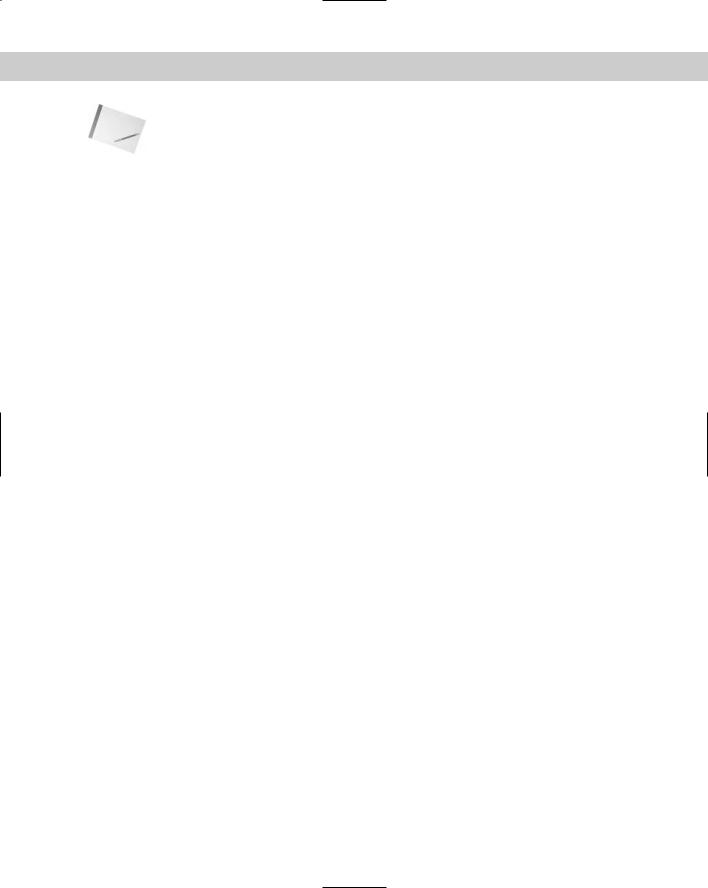
1104 Part XI Compositing and Post-Production
Note |
If the layer event is deleted, the two sub-event images remain. |
The dialog box for the Add Image Layer Event is the same as the Add Image Filter Event dialog box shown earlier except that the drop-down list includes filters that work with two images.
Adobe Premiere Transition filter
When it comes to transitions, Adobe Premiere already has created so many cool transitions that it makes sense to just use theirs. In Max, you can access these filters through the Adobe Premiere Transition Filter Setup dialog box.
This dialog box includes an Add path button to tell Max where to look for filters. All available filters are displayed in the Filter Selection list. You can access the filter interface with the Custom Parameters button. The two preview windows to the right display the filter effects. You also have options to Swap Input (which switches the source image) and Use Stand-In (which lets you specify a sample image to preview the effect).
Simple Wipe compositor
The Simple Wipe compositor is similar to the Simple Wipe filter, except that it slides the image in or out instead of erasing it. Its setup dialog box looks just like that of the Simple Wipe Control dialog box.
Other layer filters
The remaining layer filters include simple methods for compositing images and some simple transitions. None of these other filters has a Setup dialog box.
You can use the Alpha compositor to composite two images, using the alpha channel of the foreground image. The Cross Fade Transition compositor fades one image out as it fades another image in. You can use the Pseudo Alpha compositor to combine two images if one doesn’t have an alpha channel. This compositor uses the upper-left pixel to designate the transparent color for the image. The Simple Additive compositor combines two images based on the intensity of the second image.
Adding external events
The Add External Event button on the toolbar lets you use an external image-processing program to edit the image. This button is available only when an image event is selected and the image event becomes a sub-event under the external event. The Add External Event dialog box, shown in Figure 47-10, includes a Browse button for locating the external program. It also includes a Command Line Options field for entering text commands for the external program. Many external programs use the clipboard to do their processing, so the Write image to clipboard and Read image from clipboard options make this possible.
Using loop events
The Add Loop Event button is enabled on the Video Post toolbar when any single event is selected. This button enables an event to be repeated a specified number of times or throughout the Video Post range. The Add Loop Event dialog box, shown in Figure 47-11, includes a value field for the Number of Times to repeat the event, along with Loop and Ping Pong options. The Loop option repeats from beginning to end until the Number of Times value is reached. The Ping Pong option alternates playing the event forward and in reverse. You can name Loop events using the Label field.
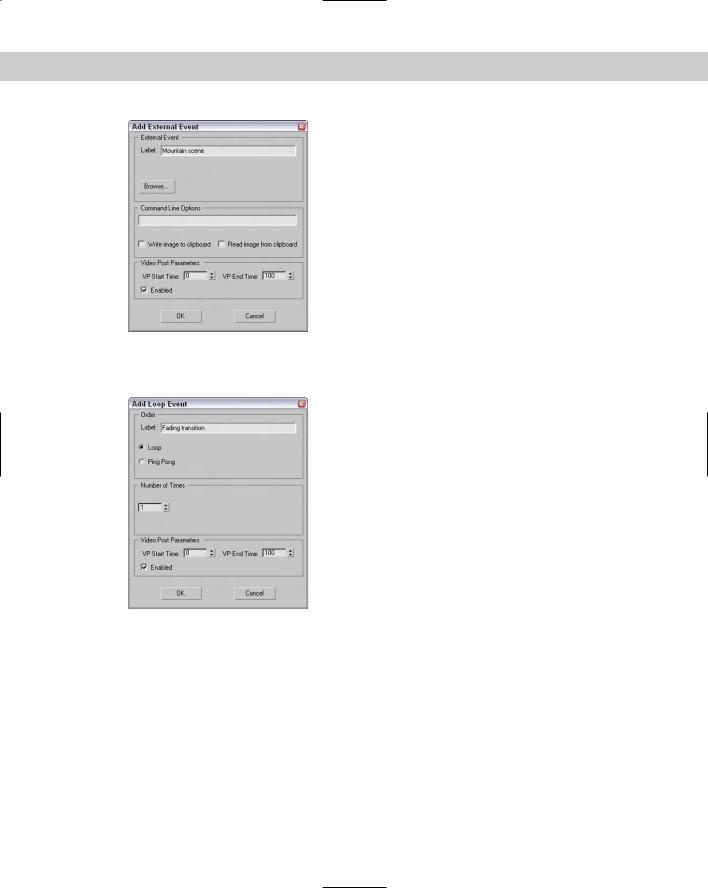
Chapter 47 Using the Video Post Interface 1105
Figure 47-10: The Add External Event dialog box lets you access an external program to edit images.
Figure 47-11: The Add Loop Event dialog box lets you play an event numerous times.
Adding an image output event
If you’ve added all the events you need and configured them correctly, and you click the Execute Sequence button and nothing happens, then chances are good that you’ve forgotten to add an Image Output event. This event adds the surface that all the events use to output to and should appear last in the queue.
The Add Image Output Event dialog box looks the same as the Add Image Input Event dialog box shown earlier. The output can be saved to a file or to a device, using any of the standard file types.
